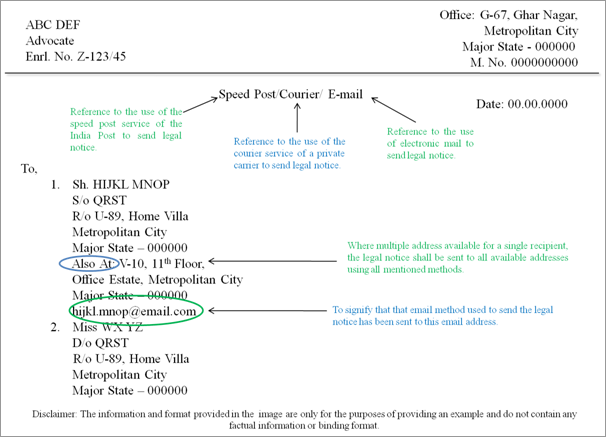Things to Remember While Drafting a Legal Notice
There is no one-size fits all checklist that can be prepared to be made applicable to all notices. What is possible though is to prepare a checklist with broad categories that are most commonly found in a legal notice. There are always various things to keep in mind while preparing a legal notice or the reply to a legal notice. This is further enhanced where there are notices with multiple technical requirements due to the nature of the notice. Below is a checklist of a few common elements of a legal notice which should be kept in mind while drafting a legal notice.
Checklist
- Correct client and receiver details
Needless to say, it is crucial to ensure that the mentioned details of the client(s) and receiver(s) of the legal notice are properly and correctly mentioned, with their complete details, as necessary and available. - Mention of all the formats used to send the legal notice
It is crucial to ensure that the legal notice is duly received by the intended recipient. Hence, often a legal notice is sent through multiple modes and channels to ensure that at least one legal notice is received by the intended recipient. This also becomes important to present before the applicable authority that all possible due diligence had been performed in order to deliver the legal notice to the intended recipient.
There are various ways through which the sender of the legal notice can ensure that there is assured delivery of the legal notice to the intended recipient(s). This is through the use of more than one mode of sending the legal notice. The modes used for sending a legal notice are usually mentioned at the top of the legal notice itself. This indicates that all of the mentioned modes of sending the legal notice have been used by the sender to send each of the intended recipients the legal notice.

Proof of Assured Delivery
Sending a legal notice by way of email where the sender has not received a “failure to deliver” email in response, is considered assured delivery. In case of sending the notice by post or courier, the receipt that the carrier gives along with its delivery report is a valid proof of such delivery or attempt made to ensure delivery. With legal notices sent by post and courier, where the delivery report comes as anything but “delivered”, the sender has the duty to explain to the court the reason the sender believed the address to be the place where the intended recipient will be usually available.
Relevance
Ensuring delivery of the legal notice, or to make best efforts to attempt delivery of legal notice is important for when the issue ends up before the court of law. Not all legal notices lead to resolution of differences at the initial stages before the issue ends up in court. Hence, it is important that all necessary document trails are prepared for if and when the issue is brought before the court of law.
Conclusion
Legal notice contributes towards formation of the base of a process of dispute resolution. Not all issues leading to legal notices end up before the court of law, but those that do put the legal notice and the entire process through strict scrutiny. The evaluation of the legal notice and its process is especially strict in instances where the legal notice is a statutory requirement and/or a strict timeline has been laid down by the law for a legal notice.


























 Toll Free No : 1-800-103-3550
Toll Free No : 1-800-103-3550 +91-120-4014521
+91-120-4014521